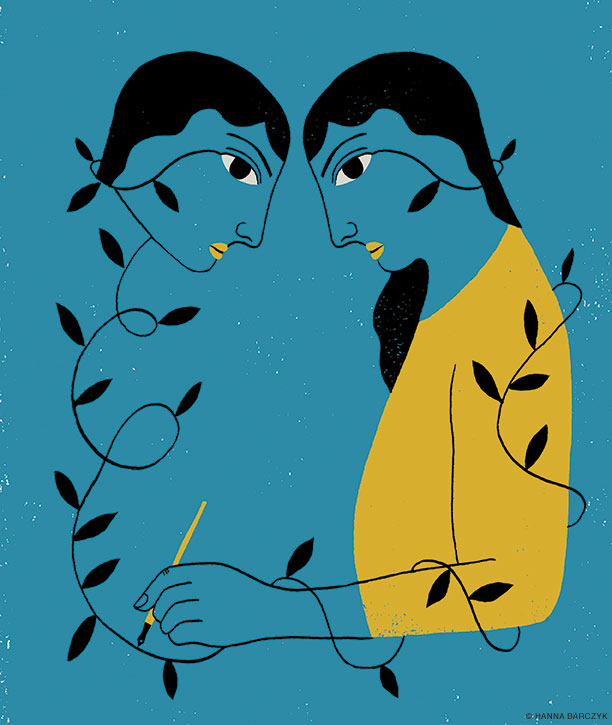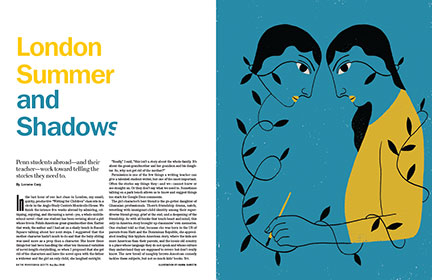
Penn students abroad—and their teacher—work toward telling the stories they need to.
By Lorene Cary | Illustration by Hanna Barczyk

In the last hour of our last class in London, my small, quirky, productive “Writing for Children” class sits in a circle in the Anglo Study Centre’s Monticello House. We finish the intense five weeks abroad by admiring, critiquing, enjoying, and discussing a novel—yes, a whole middle-school novel—that one student has been revising about a girl whose live-in Polish-American great-grandmother dies. Earlier that week, the author and I had sat on a shady bench in Russell Square talking about her next steps. I suggested that the mother character hadn’t much to do and that the baby sibling was used more as a prop than a character. She knew these things but had been handling the other ten thousand variables of novel-length storytelling, so when I proposed that she get rid of the characters and have the novel open with the father a widower and the girl an only child, she laughed outright.
“Really,” I said, “this isn’t a story about the whole family. It’s about the great-grandmother and her grandson and his daughter. So, why not get rid of the mother?”
Permission is one of the few things a writing teacher can give a talented student-writer, but one of the most important. Often the stories say things they—and we—cannot know or see straight on. Or they don’t say what we need to. Sometimes talking on a park bench allows us to know and suggest things too stark for Google Docs comments.
The girl character’s best friend is the go-getter daughter of Ghanaian professionals. There’s friendship drama, natch; wrestling with immigrant-child identity among their super-diverse friend-group; grief at the end; and a deepening of the friendship. As with all books that touch heart and mind, this only-in-America story brought up classmates’ own memories. One student told us that, because she was born in the US of parents from Haiti and the Dominican Republic, she appreciated reading this hyphen-American story, where the kids are more American than their parents, and the iconic old country is a place whose language they do not speak and whose culture they understand they are supposed to revere but don’t really know. The new breed of naughty brown-American comedy tackles these subjects, but not so much kids’ books. Yet.
After five weeks of intense work together, trips to Dickens’ and Roald Dahl’s house museums, and so many stories—Bad-Habit Rabbits, turtles, aliens; lip-synching as unintentional therapy; a too-short giraffe who grows too tall, then shrinks; and a dart-throwing, window-breaking rabbit who makes his time-out into something very like a creative writing session—these students had come to know each other’s writing, but not their childhoods. Now they shared freely: the son of a French-Canadian mother and Russian-immigrant American father speaks English, while his mother and older brother will sometimes lapse into French; the child of an Italian-American single mother told skeptical black schoolmates that she was white, only to learn that her father was Japanese-American; grandchildren of Jews who had intermarried wondered about “cultural Judaism” or breadcrumbs scattered for them to follow in the language: like the great-grandmother in the Polish story being called Bubbe. (“Is that a Jewish word? I don’t think I knew that growing up.”)
“Writing for Children” has always been an innocent course title that lets students explore, as C. S. Lewis says, “the whole cast of the author’s mind”:
We must write for children out of those elements in our own imagination which we share with children: differing from our child readers not by any less, or less serious, interest in the things we handle, but by the fact that we have other interests which children would not share with us. The matter of our story should be a part of the habitual furniture of our minds.
Some years students’ minds are furnished with joy or trauma or sexual violence or mental illness. This summer it was childhood anxiety, divorce, fitting in—or not—among school cliques, and American racism, anti-Semitism, and a dawning sense of cultural displacement, verging on homelessness, in our current fractured country as seen from an older culture, also fractious, but that was arguing with a less open, more settled story of itself.
The truckload of furniture stored in the corner of my mind was a course I’d developed but, when not enough students signed up, never actually taught. A few more takers, and the course called “Risk” would have focused on historically based fiction writing. Our subject: the legal case of the Zong, a slave ship whose crew threw 132 people overboard near Jamaica in 1781, claiming dire necessity due to disease and lack of water. Africans who survived were sold into slavery, likely into sugar production, in Jamaica, where the captain died and the ship’s log disappeared. Back in Liverpool, the ship’s owners filed with the courts saying that they should be reimbursed by their insurers for the value of the lost “stock.” A jury agreed, but the insurers balked. Chief Justice Lord Mansfield heard the appeal. His judgments had already modernized British insurance and commercial law, creating frameworks that made the British economy more efficient and that our own founders would adopt. My Zong class would have traveled to the International Slavery Museum in Liverpool, where, according to the historian David Richardson, “slaving and related trades may have occupied a third and possibly a half of Liverpool’s shipping activity in the period 1750 to 1807. The wealth acquired by the town was substantial and the stimulus it gave to trading and industrial development throughout the north-west of England and the Midlands was of crucial importance.”
In its absence the Zong course shadowed me. Writing projects often cast shadows, which it is an author’s job to find and incorporate—as Peter Pan found his and sewed it back on. Therapists similarly help individuals incorporate what we often call the shadow self. Cultures, too, readmit into their narratives the shadows cast by power or war or corruption. South Africa’s Truth and Reconciliation Commissions held that justice could only be restored by requiring citizens to testify to God-awful truths that had been buried. As recently as 2008, after decades of curricular atonement, a new comic book was introduced in German middle schools to help kids feel the lives—and deaths—of Nazi-era Jews with greater immediacy and compassion. For me, my silent, untaught course threw its own shadow over our shared London summer, and it was at its most active at the theater.
Taught by Penn-in-London director and English professor Michael Gamer (recently awarded a prestigious Global Professorship by the British Academy) and curated by London theater critic Sam Marlowe, “London Theatre” guides students through the astonishing variety and wealth of plays throughout the city, three shows each week. They discuss them the next day in Gamer’s class and write about them, sometimes overnight, like real reviewers. I was invited to attend the plays with them. My husband came to several with us; although sometimes he stayed in our funny studio flat on Goodge Street (above the Wok to Walk and opposite the Muslim World League), reading or watching the debates among the Conservative Party candidates who failed to win against Boris Johnson, who was elected Prime Minister the week after we left London.
We began with Small Island, at the Olivier in the National Theatre complex on the Thames. Based on the novel by Andrea Levy, a British writer of Jamaican descent, the play celebrated the 70th anniversary of the arrival of the HMT Empire Windrush in 1948. Taken from Germany as a prize of war, the cruise ship turned naval vessel carried more than a thousand people from the Caribbean to London. Nearly 700 meant to settle in England, including men who’d fought for the crown in World War II—and mistakenly thought that they’d be welcomed for it. Gorgeous production, with a fancy scrim and projection of the ocean; a mechanical square that lowered smoothly, removing a talkative person, still talking, whom we were told had died; a set representing a London house where rooms were let had residents who did not want to live near each other tromping up and downstairs to their cramped quarters all the day long. Jamaican independence riffed through, but oddly, in the form of an exotic character who wore ragged trousers and spoke in a heavy patois that morphed into music and movement. For British audiences the ending felt hopeful; but it was also shadowed by the 2018 Windrush scandal, in which at least 83 people from among those who had immigrated were wrongly deported, and more were illegally detained and threatened, as a result of the “hostile environment policy” enacted by Theresa May during her time as Home Secretary. I found myself wondering whether any of the Windrush generation had descended from Zong survivors. Beyond that, who among us in the 1,027-seat theater had benefited from Jamaica’s sugar production? Who had left because the fertile soil had been farmed out? What percent of the British treasury that subsidized London theater had come from the taxes on proceeds from that small island to this one?
The next night we saw The Lehman Trilogy, described in a review in The Guardian as a three-and-a half hour “intimate epic” where three virtuosic actors in three-piece, 19th-century business suits on a revolving glass-and-steel box stage trace “the trajectory of western capitalism by following the fortunes of a single family.” Simon Russell Beale, Ben Miles, and Adam Godley gave splendid performances as the original brothers who traveled from Bavaria to Alabama in the 1800s, and as all the other characters, too—brides, wives, grandchildren, toddlers, and the contemporary leaders who led the company over the cliff. Originally the brothers made their money dealing in cotton; the play said that plainly, but made no mention of how the cotton was produced so cheaply that one could turn its trading to a fortune. Nor are the actors ever called upon to portray the people, about 20 of them, whom the brothers bought to keep enslaved in their own households.
In a long, smart piece for the New York Review of Books, East Anglia University professor Sarah Churchwell writes that the National Theater in England edited out the mention of slavery from her essay for the program, and that New York’s Park Avenue Armory demurred when she offered to re-insert it for their reprint when the show played in the US last spring. With generous incisiveness, Churchwell explains:
No one involved in editing the playbills is defending or apologizing for slavery; they were doing their jobs, putting together a program of necessarily brief essays about the play as it has been produced, which does not address slavery. But the erasure of slavery from the play matters: it distorts the history of Lehman Brothers’ beginnings in the antebellum South, allowing the play to evade the question of whether making money out of money is really more reprehensible than making money out of slaves. That erasure is, ironically enough, perhaps the most allegorical aspect of the entire story: a history of American capitalism that disavows the central role slavery played in that history.
The Lehman Trilogy, edited down from its five-hour original (which also ignored slavery), performed a triumph-turned-tragedy American Dream story that explores one big contemporary shadow: the 2008 crash that triggered a global recession. Churchwell’s article is worth reading on its own for its clarifying gloss on how slavery figured in the global growth: in financial instruments, mortgages, loans, and international commerce, not to mention the development of the British shipping industry and its navy, as well as the insurance business that learned how to assess the risk incurred by companies that packed people into ships to carry them to slavery or death—either one sufficiently profitable to help the West keep growing.
The Lehman Trilogy, like Small Island, also talks to us about how we choose to tell our stories of immigration, we the country of immigrants, versus Britain, the former empire, whose subjects have longstanding but complicated and colonized connections to the mothership. How would the characters in my student’s novel, one or two generations from Korea and Ghana, Poland and India, have taken in this immigration story? My own students, still a little jet-lagged, talked at the interval, over organic cups of ice cream (but not the National Theatre’s unmatched strawberry and black-pepper!), about the dazzling production, the sound of the ocean, and the acting. Only slowly, over the following weeks, did any in our class begin to connect the Windrush generation to their own ancestors in the States—from Italy, Canada, Poland, Haiti, Russia, Japan, and the Dominican Republic.
Instead of tickets, a theater-experience called Immersive Gatsby sent typed invitations to one of Gatsby’s crazy parties that we presented to the bouncer before we were let into the warehouse/bar/West Egg mansion stand-in. Actors moved among us, performing the novel right down to the arguments, speaking the interstitial bits, acting out the doomed love-making, and so much American desire in credible American accents. We danced and drank and laughed with them, and some of the young people wore flapper dress. The actor in our class was sussed out and invited into an improv scene! But when it came time to tell us about the car accident, the script made no mention of the “pale, well-dressed Negro” whom the meticulous Fitzgerald placed at a gas station on purpose to identify Gatsby’s “…yellow car… Big yellow car.” I’d been unhappy as a young English major student to see him stationed there like a jockey on the novel’s manicured prose lawn, sure. But I was just as unhappy 40 years later to see him erased, because, in the meantime Toni Morrison’s Playing in the Dark: Whiteness and the Literary Imagination had explained Fitzgerald’s (and other white writers from Edgar Allen Poe to Willa Cather to Ernest Hemingway’s) use of the African presence as a marker. That presence told us that “the subject of the dream is the dreamer. The fabrication of an Africanist persona is reflexive; an extraordinary meditation on the self; a powerful exploration of the fears and desires that reside in the writerly conscious …”:
It requires hard work not to see this.
It is as if I had been looking at a fishbowl—the glide and flick of the golden scales, the green tip, …—and suddenly I saw the bowl, the structure that transparently (and invisibly) permits the ordered life it contains to exist in the larger world.
In other words, I began to rely on my knowledge of how books got written, how language arrives; my sense of how and why writers abandon or take on certain aspects of their project.
To write as an American in London means to wrestle with this heritage: the English language we speak and write is embedded, in form and content, with ellisions, erasures, and cultural assumptions that I cannot hear because I’ve been taught that it is our story. I’ve been taught to love it. Love it so much that I write it, code-change in it, genre change, create words, accept words, fight with, and teach it. “You are writing to say things whose meaning gets revealed in stories,” I say to our students in a building called Monticello House, which sounds like Jefferson and slavery to me, but not to the British staff. “Sometimes you are trying to say what our culture wants to shush. Because it’s been shushed. How do you say it? How do you say it to children?”
On the day before Jubilee back home in the US, and Congressional hearings about reparations, a day off from teaching, my husband and I toured Hampstead Heath, one of the great London parks that likely influenced William Penn’s plan for his “greene countrie towne” on the Delaware River. The grand house, Kenwood, has been restored to its baby-blue-and-pink neoclassical glory, with white columns and a seven-foot-tall gilded-frame mirror in the library. Over the marble mantel hangs David Martin’s gigantic 1776 portrait of William Murray, 1st Earl of Mansfield. Big bigger biggest white wig, baron’s coronation robes, double rows of seal-skin spots on the ermine-on-red-velvet cape, index finger pointing to a passage in Cicero. Whoa! Our docent swept his arm to indicate the wide entryway lined with law books and referred, I think he did, to the 1772 Somerset case where Mansfield asserted that English common law did not support slavery. Slowly it came to me that this was the Lord Chief Justice of the King’s Bench who presided over the Zong trial, he who summed up the first case by explaining that it was not about slavery, but insurance. He said that he “had no doubt (though it shocks one very much) that the Case of Slaves was the same, as if Horses had been thrown overboard …”
Mansfield pored over the facts, which included people being thrown overboard in three batches over a few days. The crew said that water was so low they’d all have died had they not culled the stock, but Mansfield found a record of rain on the day before the final mass drowning. Unlike horses, some people were said to have thrown themselves overboard to keep from being shackled first. And one person, one life-force-full African, immortalized in Fred D’Aguiar’s novel Feeding the Ghosts, swam back to the boat, caught hold of the rigging, and climbed up.
We walked out of Kenwood, smiling reflexively at the docents who smiled at us and who had not mentioned and were not thinking about the Zong. Outside, under the shiny blue sky, I felt the prick of sudden tears. They were not horses, but murdered people, whose memory had been erased yet again.
The students and I had our final individual meetings in the same shop, Coffee & Candy, where they’d laid out their proposals five weeks earlier. I’d tried to guide them to take time exploring the exquisite consciousness of their characters, from anthropomorphized little creatures to themselves now, in travel logs. And to pay attention: Why have you chosen this character? Why now? What’s the story you need to tell? What’s the form it should take? The actor had brilliantly brought his story to life as a one-act play for kids where the grumpy time-out rabbit tells the Narrator to go away! The independent adventurer had written a devastating YA piece that captures childhood by listing, with stark simplicity, “my Mom’s boyfriend,” one after another after another. Finally, just one student hadn’t quite found the clarity she needed. “You’re going round and round. We’ve said: first be clear. I don’t know what you’re circling.”
“That I feel my blackness here as much as I do in Boston. Can I just say it? Can you just, like, write it out?”
“If that’s the truth,” I said, “you have to.”
Lorene Cary C’78 G’78 is senior lecturer in English and the author of several books, most recently Ladysitting: My Year with Nana at the End of Her Century.




